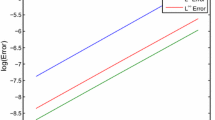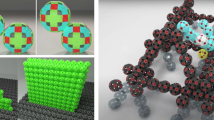Abstract
The goal of scenario reduction is to approximate a given discrete distribution with another discrete distribution that has fewer atoms. We distinguish continuous scenario reduction, where the new atoms may be chosen freely, and discrete scenario reduction, where the new atoms must be chosen from among the existing ones. Using the Wasserstein distance as measure of proximity between distributions, we identify those n-point distributions on the unit ball that are least susceptible to scenario reduction, i.e., that have maximum Wasserstein distance to their closest m-point distributions for some prescribed \(m<n\). We also provide sharp bounds on the added benefit of continuous over discrete scenario reduction. Finally, to our best knowledge, we propose the first polynomial-time constant-factor approximations for both discrete and continuous scenario reduction as well as the first exact exponential-time algorithms for continuous scenario reduction.





Similar content being viewed by others
References
Alizadeh, F., Goldfarb, D.: Second-order cone programming. Math. Program. 95(1), 3–51 (2003)
Aloise, D., Deshpande, A., Hansen, P., Popat, P.: NP-hardness of Euclidean sum-of-squares clustering. Mach. Learn. 75(2), 245–248 (2009)
Arya, V., Garg, N., Khandekar, R., Meyerson, A., Munagala, K., Pandit, V.: Local search heuristics for \(k\)-median and facility location problems. SIAM J. Comput. 33(3), 544–562 (2004)
Charikar, M., Li, S.: A dependent LP-rounding approach for the \(k\)-median problem. In: Proceedings of the 39th International Colloquium Conference on Automata, Languages, and Programming, pp. 194–205 (2012)
Conejo, A., Carrión, M., Morales, J.: Decision Making Under Uncertainty in Electricity Markets. Springer, Berlin (2010)
Dasgupta, S.: CSE 291: Topics in unsupervised learning. http://cseweb.ucsd.edu/~dasgupta/291-unsup/ (2008)
Drezner, Z., Hamacher, H.: Facility Location: Applications and Theory. Springer, Berlin (2004)
Dupačová, J.: Stability and sensitivity-analysis for stochastic programming. Ann. Oper. Res. 27(1), 115–142 (1990)
Dupačová, J., Gröwe-Kuska, N., Römisch, W.: Scenario reduction in stochastic programming: an approach using probability metrics. Math. Program. 95(3), 493–511 (2003)
Gao, R., Kleywegt, A.: Distributionally robust stochastic optimization with Wasserstein distance. (2016) arXiv:1604.02199
Graf, S., Luschgy, H.: Foundations of Quantization for Probability Distributions. Springer, Berlin (2000)
Gray, R.M.: Toeplitz and Circulant Matrices: A Review. Now Publishers, Breda (2006)
Hanasusanto, G., Kuhn, D.: Conic programming reformulations of two-stage distributionally robust linear programs over Wasserstein balls. (2016) arXiv:1609.07505
Hanasusanto, G., Kuhn, D., Wiesemann, W.: \(k\)-adaptability in two-stage robust binary programming. Oper. Res. 63(4), 877–891 (2015)
Heitsch, H., Römisch, W.: Scenario reduction algorithms in stochastic programming. Comput. Optim. Appl. 24(2), 187–206 (2003)
Heitsch, H., Römisch, W.: A note on scenario reduction for two-stage stochastic programs. Oper. Res. Lett. 35(6), 731–738 (2007)
Hochreiter, R., Pflug, G.: Financial scenario generation for stochastic multi-stage decision processes as facility location problems. Ann. Oper. Res. 152(1), 257–272 (2007)
Hopcroft, J., Kannan, R.: Computer science theory for the information age. (2012) https://www.cs.cmu.edu/~venkatg/teaching/CStheory-infoage/
Jain, A.: Data clustering: 50 years beyond \(k\)-means. Pattern Recogn. Lett. 31(8), 651–666 (2010)
Jain, A., Murty, M., Flynn, P.: Data clustering: a review. ACM Comput. Surv. 31(3), 264–323 (1999)
Kanungo, T., Mount, D., Netanyahu, N., Piatko, C., Silverman, R., Wu, A.: A local search approximation algorithm for \(k\)-means clustering. Comput. Geom. 28(2), 89–112 (2004)
Kariv, O., Hakimi, S.: An algorithmic approach to network location problems. II: The \(p\)-medians. SIAM J. Appl. Math. 37(3), 539–560 (1979)
Li, S., Svensson, O.: Approximating \(k\)-median via pseudo-approximation. SIAM J. Comput. 45(2), 530–547 (2016)
Lloyd, S.: Least squares quantization in PCM. IEEE Trans. Inf. Theory 28(2), 129–137 (1982)
Löhndorf, N.: An empirical analysis of scenario generation methods for stochastic optimization. Eur. J. Oper. Res. 255(1), 121–132 (2016)
Mahajan, M., Nimbhorkar, P., Varadarajan, K.: The planar \(k\)-means problem is NP-hard. In: Proceedings of the 3rd International Workshop on Algorithms and Computation, pp. 274–285 (2009)
Mohajerin Esfahani, P., Kuhn, D.: Data-driven distributionally robust optimization using the Wasserstein metric: Performance guarantees and tractable reformulations. Math. Program. (2017). https://doi.org/10.1007/s10107-017-1172-1
Parvania, M., Fotuhi-Firuzabad, M.: Demand response scheduling by stochastic SCUC. IEEE Trans. Smart Grid 1(1), 89–98 (2010)
Pflug, G.: Scenario tree generation for multiperiod financial optimization by optimal discretization. Math. Program. 89(2), 251–271 (2001)
Pflug, G., Pichler, A.: Approximations for probabilitydistributions and stochastic optimization problems. In: Bertocchi, M., Consigli, G., Dempster, M.A.H. (eds.) Stochastic Optimization Methods in Finance and Energy: New Financial Products and Energy Market Strategies, pp. 343–387. Springer, Berlin (2011)
Rachev, S., Römisch, W.: Quantitative stability in stochastic programming: the method of probability metrics. Math. Oper. Res. 27(4), 792–818 (2002)
Römisch, W., Schultz, R.: Stability analysis for stochastic programs. Ann. Oper. Res. 30(1), 241–266 (1991)
Römisch, W., Wets, R.: Stability of \(\varepsilon \)-approximate solutions to convex stochastic programs. SIAM J. Optim. 18(3), 961–979 (2007)
Rubinstein, R., Kroese, D.: Simulation and the Monte Carlo Method. Wiley, Hoboken (2007)
Ruiz, P., Philbrick, C., Zak, E., Cheung, K., Sauer, P.: Uncertainty management in the unit commitment problem. IEEE Trans. Power Syst. 24(2), 642–651 (2009)
Steele, M.: The Cauchy–Schwarz Master Class: An Introduction to the Art of Mathematical Inequalities. Cambridge University Press, Cambridge (2004)
Stockbridge, R., Bayraksan, G.: A probability metrics approach for reducing the bias of optimality gap estimators in two-stage stochastic linear programming. Math. Program. 142(1), 107–131 (2013)
Zhao, C., Guan, Y.: Data-driven risk-averse stochastic optimization with Wasserstein metric. (2015) Available on Optimization Online
Acknowledgements
The authors are indebted to the referees and the guest editors for their comments that considerably improved the manuscript. This research was funded by the SNSF Grant BSCGI0_157733 and the EPSRC Grants EP/M028240/1 and EP/M027856/1.
Author information
Authors and Affiliations
Corresponding author
Appendix: Auxiliary results
Appendix: Auxiliary results
The proof of Theorem 2 relies on the following two lemmas.
Lemma 1
The semidefinite program (6) admits an optimal solution \((\tau , \mathbf {S})\) with \(\mathbf {S} = \alpha \mathbb {I} + \beta \varvec{11}^\top \) for some \(\alpha , \beta \in \mathbb {R}\).
Proof
Let \((\tau , \mathbf {S}^\star )\) be any optimal solution to (6), which exists because (6) has a continuous objective function and a compact feasible set, and denote by \(\mathfrak {S}\) the set of all permutations of I. For any \(\sigma \in \mathfrak {S}\), the permuted solution \((\tau , \mathbf {S}^\sigma )\), with \(s^\sigma _{ij} = s^\star _{\sigma (i)\sigma (j)}\) is also optimal in (6). Note first that \((\tau , \mathbf {S}^\sigma )\) is feasible in (6) because
where the index sets \(I^\sigma _j=\{\sigma (i):~ i \in I_j \}\) for \(j\in J\) form an m-set partition from within \(\mathfrak {P}(I,m)\), and because \(\mathbf {S}^\sigma \succeq \varvec{0}\) and \(s^\sigma _{ii} = s^\star _{\sigma (i)\sigma (i)}\le 1\) for all \(i\in I\) by construction. Moreover, it is clear that \((\tau , \mathbf {S}^\sigma )\) and \((\tau , \mathbf {S}^\star )\) share the same objective value in (6). Thus, \((\tau , \mathbf {S}^\sigma )\) is optimal in (6) for every \(\sigma \in \mathfrak {S}\).
The convexity of problem (6) implies that \((\tau ,\mathbf {S})\) with \(\mathbf {S}=\frac{1}{n!} \sum _{\sigma \in \mathfrak {S}} \mathbf {S}^\sigma \) is also optimal in (6). The claim follows by noting that \(\mathbf {S}\) is invariant under permutations of the coordinates and thus representable as \(\alpha \mathbb {I} + \beta \varvec{11}^\top \) for some \(\alpha , \beta \in \mathbb {R}\). \(\square \)
Lemma 2
For \(\alpha , \beta \in \mathbb {R}\) the eigenvalues of \(\mathbf {S} = \alpha \mathbb {I} + \beta \varvec{11}^\top \in \mathbb {S}^n\) are given by \(\alpha + n \beta \) (with multiplicity 1) and \(\alpha \) (with multiplicity \(n-1\)).
Proof
Note that \(\mathbf {S}\) is a circulant matrix, meaning that each of its rows coincides with the preceding row rotated by one element to the right. Thus, the eigenvalues of \(\mathbf {S}\) are given by \(\alpha + \beta (1 + \rho _j^1 + \ldots \rho _j^{n-1})\), \(j=0,\ldots ,n-1\), where \(\rho _j=e^{2\pi i j/n}\) and i denotes the imaginary unit; see e.g. Gray [12]. For \(j=0\) we then obtain the eigenvalue \(\alpha + n\beta \), and for \(j= 1,\ldots , n-1\) we obtain the other \(n-1\) eigenvalues, all of which equal \(\alpha \) because \(\sum _{k=0}^{n-1}e^{2\pi i jk/n}=(1-e^{2\pi i j})/(1-e^{2\pi i j/n})=0\). \(\square \)
Rights and permissions
About this article
Cite this article
Rujeerapaiboon, N., Schindler, K., Kuhn, D. et al. Scenario reduction revisited: fundamental limits and guarantees. Math. Program. 191, 207–242 (2022). https://doi.org/10.1007/s10107-018-1269-1
Received:
Accepted:
Published:
Issue Date:
DOI: https://doi.org/10.1007/s10107-018-1269-1




